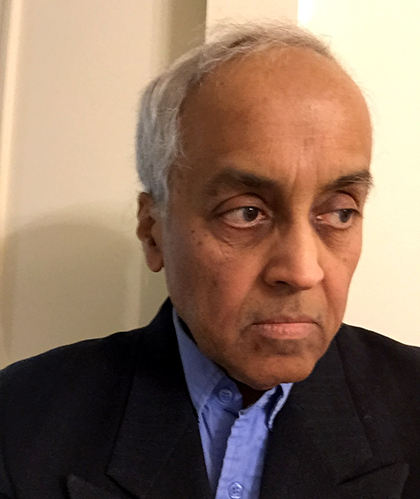Intelligent Servosystems Laboratory
The Intelligent Servosystems Laboratory (ISL) was the first lab in the Institute for Systems Research devoted to problems in robotics. It has been directed since its founding in 1986 by Professor P. S. Krishnaprasad (ECE/ISR). The lab has concentrated on the mathematical control of robotic servosystems, from geometric control to collective behavior.
The work of the lab has been informed by the interests of a number of collaborators, including Roger Brockett, Lung Wen Tsai, Wijesuriya Dayawansa, John Baras, Josip Loncaric, Gregory Walsh, Dimitris Hristu and several generations of University of Maryland students in electrical and computer engineering, mechanical engineering and computer science. Many interesting ideas, technologies and artifacts have emerged from this collaborative work, including the modular dexterous hand, the hybrid motor and the parallel manipulator.
The biologically inspired sound localization algorithms and motion control software MDLe developed in ISL bring together control, signal processing and the natural world. MDLe has been used to guide an auditory-enabled mobile robot to track sound sources. Understanding key aspects of the barn owl’s auditory system was essential to developing robust solutions. MDLe is now part of a commercial implementation.
Nonlinear filtering is a basis for a variety of estimation problems, including system identification. Modern approaches exploit computational advances by stochastic simulation leading to a family of particle filters. The ISL originated the projection particle filter with continuous time dynamics and exponential families. The orthogonal matching pursuit algorithm is an efficient and widely-used tool for constructing approximations. A variety of technologies, including tactile sensing and acoustic guidance in robotics, and adaptive optics for correcting wavefronts distorted by propagation media, influenced the novel solutions to inverse problems emerging from ISL work.
Actuators and mechanisms display non-ideal nonlinear behavior due to backlash in gear trains, friction in bearings, impact during contact, and hysteresis in constitutive relations. Mitigating the influence of such uncertain behavior on the performance of robotic devices and systems demands a multi-pronged effort through modeling, inversion and control. The exploitation of coupled fields in “smart material” hysteresis was investigated by resorting to microscopic modeling via the Landau-Lifshitz equations, and phenomenological input-output descriptions such as the one associated with Preisach and others in magnetism. Alternative low-dimensional models for ease of use in real-time control applications also have been investigated in ISL.
ISL has been active in the exploration of interactions amongst agents leading to collective behavior, and has been inspired by models based on gyroscopic forces developed in Krishnaprasad’s study of prey-capture behavior in bats (joint with Cynthia Moss and students). Pursuit is a special class of strategies, and a mechanical activity in natural foraging and other behavior. The ISL studies the role for such strategies as building blocks for coherent structures (flocks, swarms, schools, etc.) A collaboration with Italian physicist Andrea Cavagna on flocking and swarming in birds and insects is relevant to collective robotics.
In 2013 the ISL underwent a significant transformation thanks to a FY2012 AFOSRDURIP grant. The grant has enabled ISL to acquire and install a physical test-bed system for synthesis of collective behavior from fundamental building blocks. In the testbed is a collection of 10 wheeled robots equipped with motion control software, four of which have manipulator arms. Robot motion is planar, but manipulator arm end-effectors and grasped objects equipped with optically reflective markers are articulated to provide 3D trajectory data. The testbed also includes a networked system of 14 motion capture infrared cameras, two visible light video cameras, and associated computational and control equipment, and software to collect, store, track, and share real-time position data of reflective markers on robots.
ISL computational resources have also been enhanced to work with the emerging large datasets from the test-bed system. One of two workstations is dedicated to large scale offline computations with natural and robotic trajectory data, and the other with real-time computations for closed-loop control of robot collectives using VICON tracking data. This system will greatly advance solution of inverse problems for trajectory data on natural collectives (of starlings), and prototyping of strategies and algorithms for control signals in robot collectives.
Senior Ph.D. students Biswadip Dey and Yunlong Huang are engaged in basic research in collective behavior and non-equilibrium systems respectively. Using a broad array of mathematical methods, control-theoretic formulations and tools, and computational exploration, they gain insight into nature and autonomous engineered systems. They use the ISL facilities to advance their computational work, to explore ideas in robotic platforms, and guide undergraduates in their projects. More junior graduate students use ISL facilities to develop a better understanding of the basic questions of interest in the field of intelligent systems.
Undergraduate projects are making effective use of these new facilities, with students writing code and developing analyses of feedback laws to explore the building blocks of collective behavior derived from pursuit laws. The mathematical models and theoretical work of P. S. Krishnaprasad and his collaborators (in particular, Eric Justh and Kevin Galloway) are being shaped into real-time control software for investigating a range of questions including obstacle avoidance and collective prey capture.

|
P. S. KrishnaprasadProfessor301.405.6843 | krishna@umd.edu Profile |
Top